This was published 2 years ago
Our yearly leftovers would fill the MCG 10 times over: The new plans for food waste
Australians waste the equivalent of 312 kilos of food – most of it edible – per person. Meet the innovative minds figuring out how to dispose of the problem.
By Dani Valent
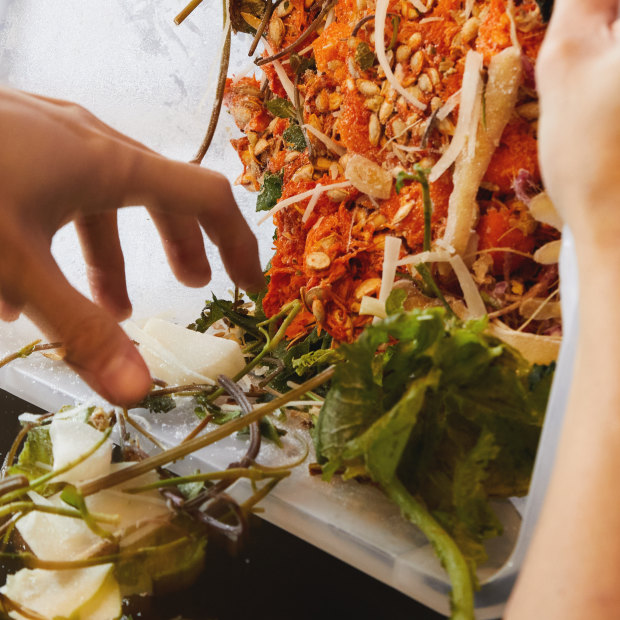
If food waste was a country, it would be the third-biggest source of greenhouse gas emissions after the US and China.Credit: Peter Tarasiuk
I keep thinking about a pear, the lovely green one that I bought at my local fruit shop two weeks ago and put in the fridge with mandarins and some grapes. A week later, it was still there, so I moved it to the benchtop fruit bowl, hoping that visibility would equal edibility: one of the kids would see it, eat it and compost the core. Often that works, but this time it didn’t. Day turned to night then to day and the pear stayed put. Tidy green turned to spotty yellow. The stalk listed. One pert pear bum-cheek subsided into the base of the fruit bowl, then split like a bedsore. Nicks appeared by the neck – an incident with a banana?
I should cook that, put it in a cake, stew it to serve with muesli, I thought in passing. And then I didn’t. As I write this, I have got as far as taking it out of the fruit bowl to sit on the bench, a solo sentinel of profligacy, bad planning, inept parenting, lazy housekeeping, society on the verge of climate collapse. It’s there now, just a pear, but also part of a big problem.
If food waste was a country, it would be the third-biggest source of greenhouse gas emissions after the US and China, according to the UN’s Food Waste Index Report, released last year. When foods like my pear end up in landfill, they slowly rot, generating methane and carbon dioxide.
One problem with calculating the scale of the problem is the lack of accurate data and agreed definitions on what counts as waste from the vast majority of the world. The UN estimates that 17 per cent of global food production was wasted pre-pandemic, tallying to almost one billion tonnes a year. Australia is an outsized contributor, producing 7.6 million tonnes of food waste per year, the equivalent of 312 kilograms per person, according to a waste strategy paper released by Food Innovation Australia. Approximately 70 per cent of this is edible – this at a time when one in six Australian adults struggled to access enough to eat in the past 12 months.
“Australia’s food waste would fill the MCG 10 times each year, or would fill semi-trailers stretching from Perth to Sydney,” says Steven Lapidge, chief executive of the federally funded Fight Food Waste Cooperative Research Centre.
“We spend billions building better roads, and we don’t spend anything like that on trying to reduce food waste and the negative consequences of that wasted food.”
The impact is considerable: food waste accounts for 3 per cent of Australia’s greenhouse gas emissions, equivalent to an average car driving around the world 2 million times. It’s costly, too. The average Australian household fritters away up to $2500 a year buying food that isn’t eaten, and national food waste costs us about $36.6 billion a year.
“It’s more than what road congestion costs Australia in terms of lost productivity,” says Lapidge. “But we spend billions building better roads, and we don’t spend anything like that on trying to reduce food waste and the negative consequences of that wasted food, which is the significant amount of greenhouse gas emissions it creates.”
Australia classes such waste as food or drink intended for human consumption that either does not reach the consumer or is thrown away after it does. Discarded seeds, bones and peels are counted as waste to encourage a rethink: grape skins and seeds left over from wine-making can be used as an ingredient for nutraceuticals, for example. Human-grade food that’s fed to livestock isn’t waste; throwing the dog a bone is, though some argue it shouldn’t be. Food rescued by charities is not waste, as long as the food ends up eaten. Compost is considered waste, though it’s further up the hierarchy than landfill because emissions are greatly reduced by the aerobic breaking-down of organic matter. The counting is complicated, but there’s no doubt about what’s worst: the most damaging action of all is putting food into the bin.
In 2015, the UN laid out the challenge in its Sustainable Development Goals, a blueprint of 17 objectives to remake the world. Goal 12 is to ensure sustainable consumption and production patterns, with target 12.3 specifically aimed at halving global food waste by 2030. Australia has pledged to work towards this goal under the auspices of a National Food Waste Strategy, a network of initiatives that prioritises industry-led action. But anyone can tackle food waste – it’s solvable pear by pear. Who are the champions showing us how it’s done, by being inspiring and innovative, and helping to save the world along the way?
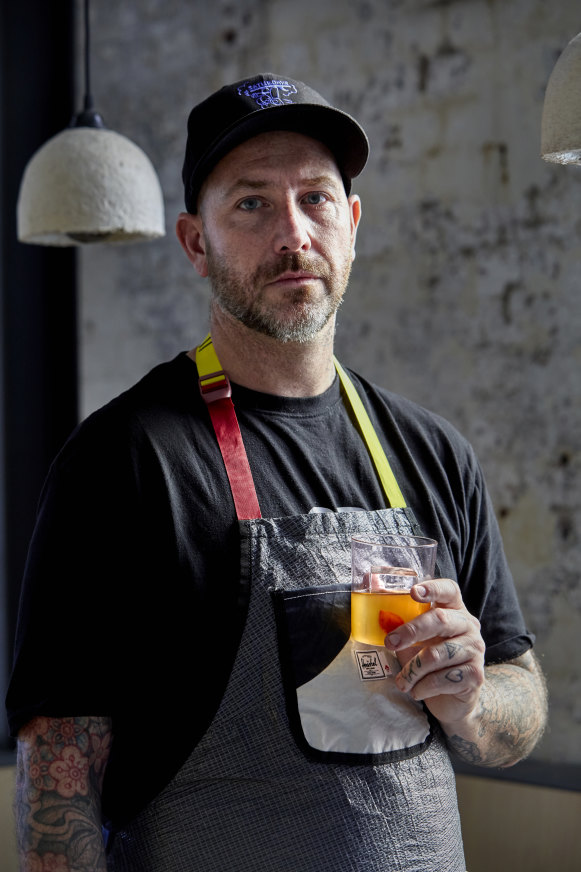
Matt Whiley creates cocktails from surplus produce at Sydney bar, Re. “We’re starting conversations,” he says.Credit: Jennifer Soo
Canny chefs and bartenders
Matt Whiley’s inventory looks completely different from that of the average bar. “Our ingredient list might include strawberry tops, lamington offcuts from a local bakery and rescued plums from a greengrocer nearby,” says the bartender, standing by the coolroom in Sydney’s high-concept Re. The idea behind the cocktail venue and kitchen in Eveleigh is to make a menu out of surplus food and by-products that would otherwise be binned, mostly by other commercial kitchens.
The strawberry tops are infused into water that’s added to a gin cocktail. Lamington scraps are distilled with spirit, then blended into a coconut cocktail. The plums are reduced to a syrup, then turned into an aromatic liquor. “It’s rewarding, a really good feeling,” says Whiley. “When you work in food and drink, you see so much waste. It’s almost built around it. I couldn’t deal with throwing stuff out any more, so I decided to change things up.”
Making waste reduction fundamental means Re runs differently to other bars. The team only brings in produce it believes can be turned over quickly. “For our first six months, our fridges were always full,” says Whiley. “Now they are pretty much empty. That’s half the battle: humans over-consume and then things end up in the bin.”
At Re, every plate is analysed once a customer has finished eating. “If a dish constantly comes back unfinished, you know your portion size is off, so you scale it down, order less, and charge a little less.” It also has six bins – compost, glass, paper, waste, laundry and soft plastics – and there are notebooks next to the bins. “Whenever someone puts anything in the general waste or the compost bin, they have to write down what it was, why it’s been wasted, and what could be done differently next time,” he says. “You’ve got to hold yourself accountable.”
“If a dish constantly comes back unfinished, you know your portion size is off, so you scale it down, order less, and charge a little less.”
Whiley is under no illusions about his impact. “We’re small,” he says. “If it’s sunny, our capacity is 86 guests, inside and out. If it’s raining, it’s 46. We are highlighting a problem and also showing how to solve it. To say that we’re making change would be a lie. But we are starting conversations. We’re bringing venues together. How can what we’re doing in Sydney filter into Melbourne, Brisbane, all the towns and cities all over Australia? And then how does Australia take that to the world?”
In Melbourne, chef Dennis Yong was disillusioned by a kitchen culture which saw bins filled every day. “‘If you chuck it away, you don’t have to care about it,’ ” he says. “That’s the mentality. Cucumber peel or apple peel or leftover rice, you don’t use it.” Yong didn’t grow up like that. “In Malaysia, my grandma always put leftovers in the fridge, and she would wash, dry and reuse plastic bags,” he says. “Poor people don’t throw things out. The whole idea of fried rice is that it’s from the day before: it dries a little and gives it that al dente texture the next day.”
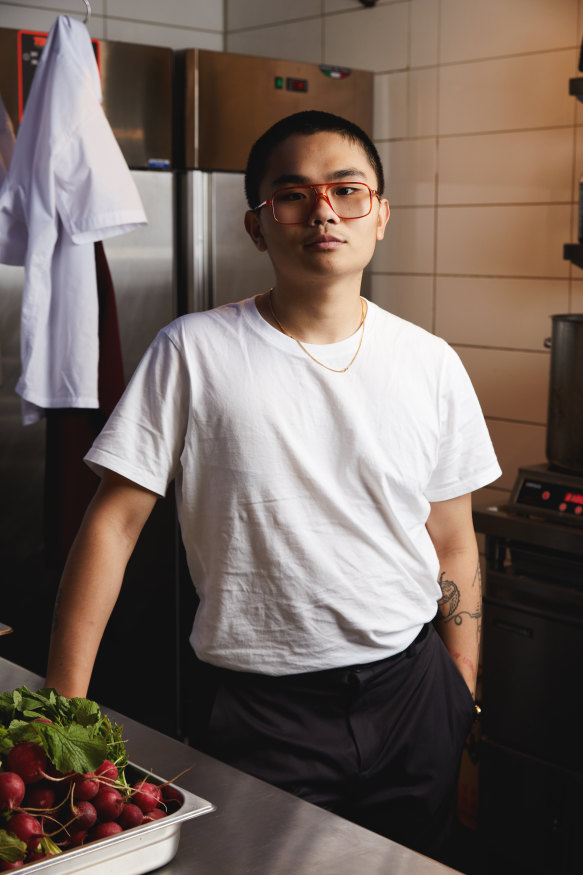
Dennis Yong’s menu at Melbourne’s Parcs is based on offcuts, seconds, rescued food, and fermentation.Credit: Peter Tarasiuk
As a trainee chef, he saw potential dishes scraped into the bin all the time. “Cuttings and scraps are full of promise,” he says. He’s proving that now at Parcs (“scrap” backwards), a small city dining room where the menu is based on offcuts, seconds, rescued produce and – crucially – fermentation.
“Food waste and fermentation are a perfect marriage,” he says. “If you take scraps and ferment them, you can extend their life for years.” He makes kimchi, pickles, kombuchas and preserves, as well as a “treacle” made from the likes of melon peel, herb stems, onion skin and garlic skin. “Rather than making a mirepoix with fresh carrot, onion and celery as the base for a dish, I use whatever scraps I have at the end of the day to make my treacle sauce that does the same job.”
Yong’s creations have also sprung from back-alley trawls and bin-foraging. “I would see a whole binful of tomatoes at the Vic Market or a huge bin at Woolies – double my height, I climbed up – that was full of carrots and celery. It was crazy. If you peel the skin, you get a perfect carrot. It was depressing, but then I got inspired. Someone has to do something about this.”
Dining culture isn’t always his friend. “With chefs, there’s often this idea that fresh produce makes your food better,” he says. “Does it matter, though? For me, as long as it’s edible, a carrot is a carrot. I don’t think it makes that much difference to the flavour or the finished dish. We need to use the carrot that is going to go bad first and use the new one later on. We need to solve the problem right now rather than create a new problem.”
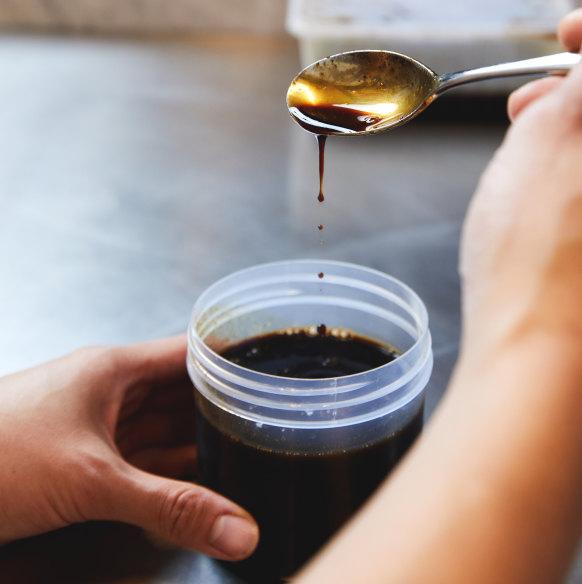
Yong makes a “treacle” from the likes of melon peel, herb stems, onion skin and garlic skin. Credit: Peter Tarasiuk
Super-mindful suppliers
Two years ago, Josh Brooks-Duncan and Josh Ball, mates and business students at Melbourne’s RMIT University, wandered through the monthly farmer’s market in seaside St Kilda. “We noticed that a lot of the produce didn’t look the same as the supermarket,” says Brooks-Duncan. “It was bent, misshapen, it looked … natural. We started researching and realised that there was a huge issue with food waste due to aesthetics.”
Up to 25 per cent of Australian produce never leaves farms, according to a 2017 federal government report, because it’s marked, or non-standard in size or shape, and therefore doesn’t meet buyer specifications. That means one-quarter of the water used to grow our food is wasted, too.
“One that gets me every time is celery,” he says. “Supermarkets only buy a specific size that fits into standardised tubs, so farmers often rip sticks off the outside of the celery – up to 40 per cent of the plant is discarded. But the outer sticks are the best, crunchiest, biggest, tastiest. And they are ploughed back into the farm or thrown in the bin.”
The pair saw a chance to make a difference. “We learnt that food waste is a huge driver of climate change,” says Ball. “Throw in a business degree and you have an eye on opportunity.” Four months after that day, they launched Farmers Pick, a vegetable- and fruit-box service that puts “imperfect” produce on consumers’ doorsteps, initially in Melbourne and now also in Sydney.
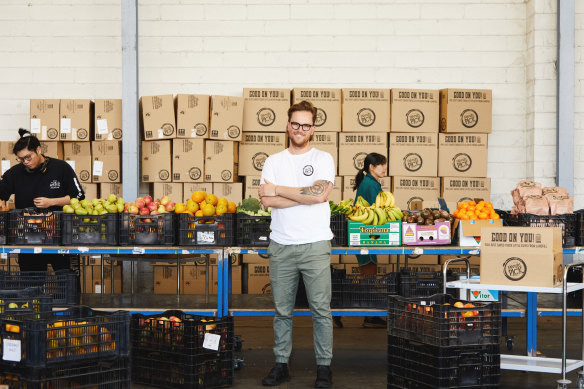
Josh Ball co-founded Farmers Pick with his friend Josh Brooks-Duncan.Credit: Peter Tarasiuk
They work directly with farmers to collect those celery sticks, plus kinky carrots, oversized mushrooms, teeny pumpkins and anything else that doesn’t fit the specs. Customers pay 30 per cent less than the same “perfect” produce would cost in standard retail outlets.
“Taste and nutrition should be the most important aspects for food, but aesthetics have become number one,” says Ball. “Decades of marketing and mass commercialisation have swayed people to what a good product is: we’re dealing with Photoshopped tomatoes like we deal with Photoshopped people in magazines. These aren’t realistic standards for people, and they aren’t realistic for produce, either. We want to put pressure on big chains to rethink their unrealistic beauty standards.”
There’s change afoot: Farmers Pick rescues 20 tonnes of produce a week and delivers 1500 boxes. The cost savings for households are considerable, but there are broader impacts, too. Produce that never leaves farms still costs farmers in water, fertiliser, tractor fuel and labour and they try to recoup their losses by increasing the price on produce that does make it further along the supply chain. Less waste should mean lower prices for all consumers.
“I’m not delusional – it’s a huge uphill battle,” says Ball. “But we’ve had 3000 per cent growth in six months. I’m optimistic and excited seeing the community gathering around the movement. It’s empowering. I think Australians are up for it.”
“We’re dealing with Photoshopped tomatoes like we deal with Photoshopped people in magazines.”
Sukhi Saini is operations manager at Agrico Produce, a western NSW farm that supplies Farmers Pick with garlic and pumpkins. Heavy November rains meant this year’s garlic crop was harvested in damp conditions. “Humidity led to stains on the garlic and also meant that stems came off when we pulled the garlic from the ground,” he says. “It doesn’t help the storage process if the conditions during harvest are less than ideal. More than 60 per cent of the crop had stains or damaged stems.”
Regular suppliers wouldn’t take it, but Farmers Pick did. “It doesn’t look good but if you cook with it, you’ll be blown away,” says Saini. He sells seconds at 30 to 50 per cent of the premium produce price. “We don’t grow to put in the bin. Having a home for our produce makes it all worthwhile.”
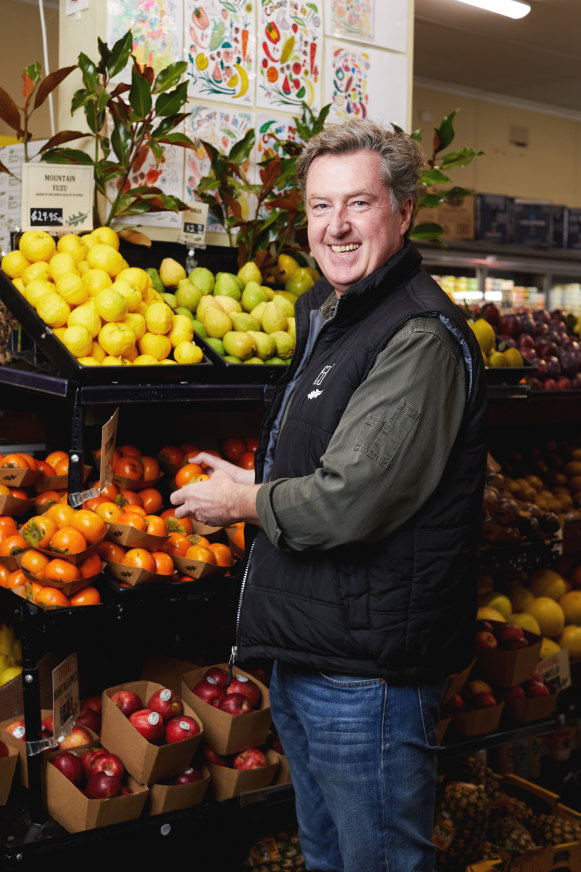
Melbourne grocer Leon Mugavin strives to reduce food waste by concentrating on the flavour of produce rather than its looks. Credit: Peter Tarasiuk
Greengrocer Leon Mugavin owns Leaf Stores in Melbourne’s Elwood and Hawthorn. His purchasing is driven first by flavour, then by stopping food waste, next by commercial viability. “In summer, I was buying plums with a scuff mark on them which were perfectly fine to eat,” he says. “It’s a harder sell – customers have to trust you.”
He leans on that trust to save produce. “When organic bananas ripen, they don’t have a long shelf life,” he says. Mugavin will buy them – as long as they taste great – and they’ll be the only banana in store. “We won’t even give the customer a choice. I will tell my audience on Instagram that we need to eat this now to stop food waste.” So long as the flavour’s there, the approach works. “It has to be driven by taste,” he says. “It can’t be imperfect for the sake of being imperfect but if it’s good, I’ll make the effort to sell it.”
Ten-tonne techies
At large and small scales, entrepreneurs are creating technology to keep food from becoming landfill. Yume is a social enterprise that works at a commercial level, using an online sales platform to connect food at risk of being wasted with buyers who purchase it at a discount. If items aren’t sold, they’re automatically offered to food charities. It might be 10 pallets of a discontinued flavour of ice-cream, a cancelled order for a tonne of salmon or a truckload of cheese close to its best-before date.
“We had 15 tonnes of cream cheese due to go to export but it didn’t make the labelling standard,” explains CEO Katy Barfield. “Because it had Chinese writing on it, it wouldn’t be put into the Australian market and was on its way to landfill.” Swooping in superhero-style, Yume was able to find a local dips maker who bought it. “It’s a win all round.”
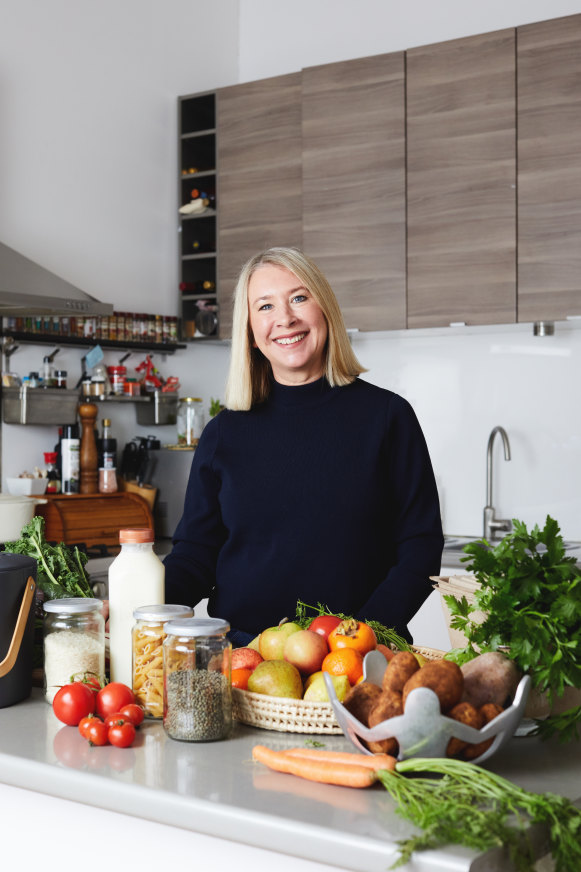
Katy Barfield runs Yume, an online commercial-scale enterprise connecting buyers with food at risk of going to waste.Credit: Peter Tarasiuk
Recently, 98,800 kilograms of diced tomatoes from a large manufacturer were at risk of going to waste. Yume connected them to a local curry supplier, who purchased the lot to use in meals. “Last week, we had two tonnes of roquefort cheese, which a major retailer decided to take off the shelves,” says Barfield. “It hadn’t sold the way they expected, but it was fantastic cheese. It went through to an airline’s business lounge. Why not when it’s $10 rather than $70?”
Natalie Sarau has just launched Forkful, an online marketplace that allows cafes and restaurants to alert consumers to discounted surplus and unsold products that might otherwise be binned. “It’s like Airbnb but instead of looking for a place to stay, you’re looking for something to eat in your local area,” she says.
A cafe that has 10 muffins left at 3pm can register them on the platform and parents looking for lunchbox treats for the next day can pick them up on the school run, or a bakery can offload unsold loaves for tomorrow’s toast. The platform is currently running in test mode in Darebin, a municipality in northern Melbourne. It’s small but every muffin counts. “Platforms like Forkful have saved 180 million meals around the world in seven years,” says Sarau.
The rest of us
We can blame profligate manufacturers, evil supermarkets and chefs obsessed with the perfect carrot, but regular eaters are the biggest culprits when it comes to food waste. It’s not just that 61 per cent of global food waste at the consumer level comes from households (as against 26 per cent from food service and 13 per cent from retail), it’s that the food wasted in households has travelled furthest along the supply chain, sucking up fuel, power and labour at every step.
“We look to blame everyone else for the woes of society, but this one is really on our shoulders,” says Fight Food Waste’s Steven Lapidge. “There’s never a good reason to waste food but if you are going to do it, it’s better to do it early on – such as on the farm – so you don’t put all the additional resources into it.”
Google shows more than 23 million results for “carrot-top pesto”, and homemade kimchi – preserved cabbage – is the new marmalade.
Whether the motivation is caring for the environment, clawing back the up-to-$2500 wasted in the average household each year or reducing food insecurity, the actions and interventions are similar. “It’s about buying the right amount of food, making sure you store it properly and eating your leftovers,” says Lapidge. What you can’t eat, feed to pets if it’s safe to do so, or compost. Home fermenting and eating scraps are options too: Google shows more than 23 million results for “carrot-top pesto”, and homemade kimchi – preserved cabbage – is the new marmalade.
Yume’s Katy Barfield is unsure. “I’m not going to turn watermelon rind into a pickled masterpiece,” she says. “I have two children, one with additional needs, and I’m trying to build a business. I don’t have time.” But she’s sure about one thing. “Do whatever you can to not put food in the bin.”
I’ve still got that pear. I peel it, give the skin and core to the worms, and stew the soft, juicy flesh in a little pot with cinnamon and star anise. I eat it on my doorstep, breathing shared air in a shared world. It’s sweet though a little grainy, a day or two past its best. What it isn’t doing is rotting in the bin, coughing up methane. My righteous little compote isn’t much but at least my pear makes sense. It’s fruit that is finally fruitful.
To read more from Good Weekend magazine, visit our page at The Sydney Morning Herald, The Age and Brisbane Times.
The best of Good Weekend delivered to your inbox every Saturday morning. Sign up here.